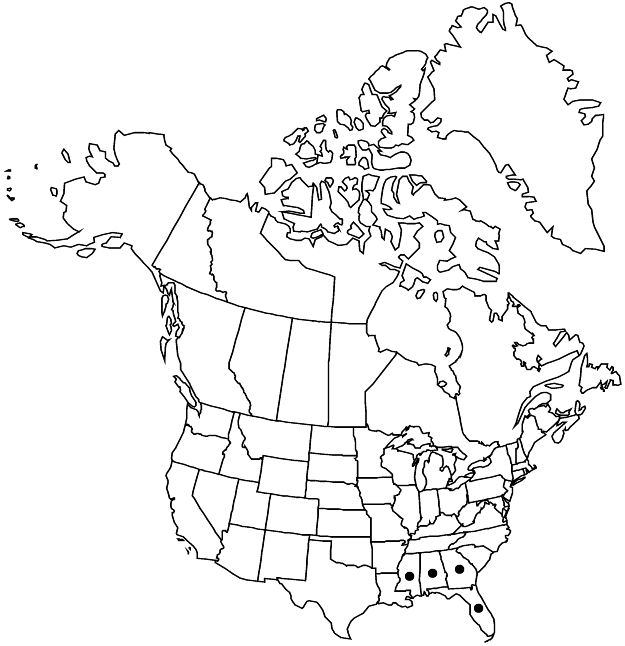Difference between revisions of "Euphorbia inundata"
Fl. South. U.S., 402. 1860.
FNA>Volume Importer |
RevisionBot (talk | contribs) m (Bot: Adding category Revised Since Print) |
||
| (6 intermediate revisions by 3 users not shown) | |||
| Line 10: | Line 10: | ||
|special_status={{Treatment/ID/Special_status | |special_status={{Treatment/ID/Special_status | ||
|code=F | |code=F | ||
| − | |label= | + | |label=Illustrated |
}}{{Treatment/ID/Special_status | }}{{Treatment/ID/Special_status | ||
|code=E | |code=E | ||
| Line 19: | Line 19: | ||
|name=Galarhoeus inundatus | |name=Galarhoeus inundatus | ||
|authority=(Torrey ex Chapman) Small | |authority=(Torrey ex Chapman) Small | ||
| + | |rank=species | ||
}} | }} | ||
|hierarchy=Euphorbiaceae;Euphorbia;Euphorbia sect. Nummulariopsis;Euphorbia inundata | |hierarchy=Euphorbiaceae;Euphorbia;Euphorbia sect. Nummulariopsis;Euphorbia inundata | ||
| Line 30: | Line 31: | ||
-->{{Treatment/Body | -->{{Treatment/Body | ||
| − | |distribution= | + | |distribution=Ala.;Fla.;Ga.;Miss. |
|discussion=<p>Varieties 2 (2 in the flora).</p><!-- | |discussion=<p>Varieties 2 (2 in the flora).</p><!-- | ||
| − | --><p><i>Euphorbia inundata</i> has a disjunct distribution in the southeastern United States. Allopatric, narrow-leaved populations from the west-central Florida peninsula are segregated as < | + | --><p><i>Euphorbia inundata</i> has a disjunct distribution in the southeastern United States. Allopatric, narrow-leaved populations from the west-central Florida peninsula are segregated as <i></i>var.<i> garrettii</i> (E. L. Bridges and S. L. Orzell 2002).</p> |
|tables= | |tables= | ||
|references= | |references= | ||
| Line 55: | Line 56: | ||
-->{{#Taxon: | -->{{#Taxon: | ||
name=Euphorbia inundata | name=Euphorbia inundata | ||
| − | |||
|authority=Torrey ex Chapman | |authority=Torrey ex Chapman | ||
|rank=species | |rank=species | ||
| Line 62: | Line 62: | ||
|basionyms= | |basionyms= | ||
|family=Euphorbiaceae | |family=Euphorbiaceae | ||
| − | |distribution= | + | |distribution=Ala.;Fla.;Ga.;Miss. |
|reference=None | |reference=None | ||
|publication title=Fl. South. U.S., | |publication title=Fl. South. U.S., | ||
|publication year=1860 | |publication year=1860 | ||
| − | |special status= | + | |special status=Illustrated;Endemic |
| − | |source xml=https:// | + | |source xml=https://bitbucket.org/aafc-mbb/fna-data-curation/src/2e0870ddd59836b60bcf96646a41e87ea5a5943a/coarse_grained_fna_xml/V12/V12_477.xml |
|genus=Euphorbia | |genus=Euphorbia | ||
|section=Euphorbia sect. Nummulariopsis | |section=Euphorbia sect. Nummulariopsis | ||
| Line 73: | Line 73: | ||
}}<!-- | }}<!-- | ||
| − | -->[[Category:Treatment]][[Category:Euphorbia sect. Nummulariopsis]] | + | --> |
| + | |||
| + | [[Category:Treatment]] | ||
| + | [[Category:Euphorbia sect. Nummulariopsis]] | ||
| + | [[Category:Revised Since Print]] | ||
Latest revision as of 18:10, 6 November 2020
Herbs, perennial, with thickened rootstock. Stems erect or ascending, 15–40 cm. Leaves: petiole absent or indistinct, blade linear to linear-elliptic or lanceolate, (25–)30–60(–115) × 1.5–14(–15) mm, chartaceous, base attenuate, apex acuminate, acute, or rounded and mucronate; only midvein evident. Cyathial arrangement: terminal pleiochasial branches 2–3, 5–18 cm, 3–8 times 2-branched; pleiochasial bracts linear-lanceolate or narrowly ovate, 25–49 × 5–9 mm, margins entire, apex acute or acuminate; dichasial bracts ovate or lanceolate, 6–21 × 2–6 mm, margins entire, apex acute or acuminate; axillary cymose branches 1–5. Cyathia: peduncle 6–24 mm (often exceeding dichasial bracts). Involucre obconic or campanulate, 1.3–3.2 × 1.6–3.6 mm, lobes ovate, oblong, or nearly rectangular, 0.6–1 mm, laciniate-ciliate; glands red to greenish, oblong or nearly circular, 0.8–1 × 1.1–2 mm, distal margins crenulate-erose, undulate, or entire. Staminate flowers 20–25. Pistillate flowers: gynophore exserted 2.6–6.1 mm, calyxlike lobes triangular to subulate, 0.6–1.4 mm; styles connate 1/8 length, 1.3–2.2 mm. Capsules oblate-ovoid, 5.1–6.1 × 6.9–8.6 mm, 3-lobed; columella 3.9–4.7 mm. Seeds brown to blackish, ovoid-globose, circular or faintly 3- or 4-angled in cross section, 2.9–3.4 × 2.7–3 mm, smooth, base flattened or rounded, apex rounded or with inconspicuous blunt point.
Distribution

Ala., Fla., Ga., Miss.
Discussion
Varieties 2 (2 in the flora).
Euphorbia inundata has a disjunct distribution in the southeastern United States. Allopatric, narrow-leaved populations from the west-central Florida peninsula are segregated as var. garrettii (E. L. Bridges and S. L. Orzell 2002).
Selected References
None.
Key
| 1 | Leaf blades usually linear to narrowly elliptic or narrowly lanceolate, rarely oblanceolate, (3–)4–14(–15) mm wide, length usually 5–10(–25) times width; apex obtuse to short-acute; se Mississippi to ne Florida. | Euphorbia inundata var. inundata |
| 1 | Leaf blades narrowly linear, linear, or narrowly linear-lanceolate, 1.5–3.5(–4.5) mm wide, length 15–20(–50) times width, apex short-acute to acuminate; wc Florida. | Euphorbia inundata var. garrettii |